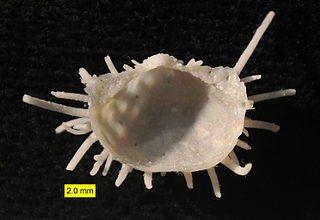
The Acrotretida are a group (order) of sessile, suspension-feeding brachiopods known from the Cambrian period and surviving until the present day. Their shell has a round outline, and is usually phosphatic in recent specimens.

Lingulida is an order of brachiopods.
Paterinata is an extinct class of Paleozoic Era Linguliform brachiopods.

Productida is an extinct order of brachiopods in the extinct class Strophomenata.
Strophomenoidea is an extinct superfamily of prehistoric brachiopods in the order Strophomenida.
Orthotetida is an order of brachiopods containing the families:
An order of brachiopods containing the families:
A rhynchonelliform class, characterised by the presence of a colleplax; closest relative (?): Salanygolina.
Protorthida is an extinct order of Rhynchonellate brachiopods containing the taxa:
A subfamily of orthid brachiopods, containing:
A superfamily of brachiopods containing:
Orthoidea is a superfamily of brachiopods containing the families:
A superfamily of brachiopods containing:
Plectambonitoidea is a suborder of brachiopods containing the families:
A suborder of brachiopods containing the families:
Productidina is a suborder of brachiopods containing the families:
Strophalosiidina is a suborder of Brachiopod containing the families:
A suborder of brachiopods containing the families:
Acrotretidae is a family of brachiopods, the type family of the Acrotretida order.
Glyptoria is a genus of protorthid brachiopod with a ventral spondylium. It is characterized by a free apical plate in the ventral valve interior and a distinctive coarse, lamellose ornament.


